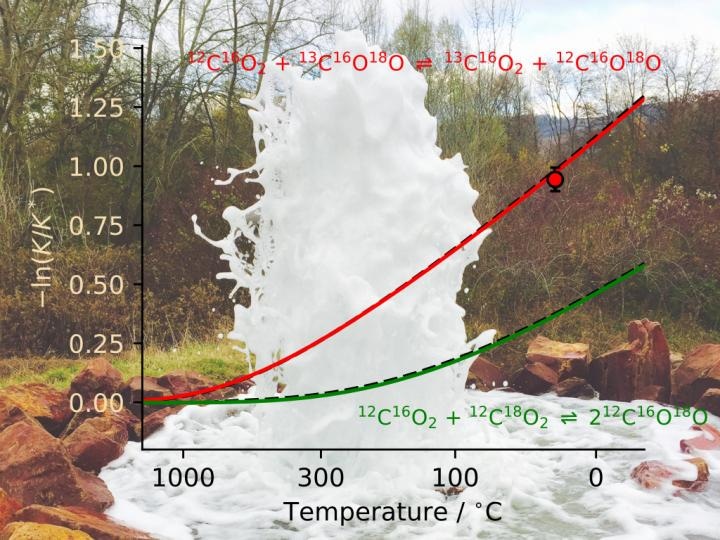May 21 2019
An innovative laser instrument now enables simultaneous measurement of four rare molecular variants of carbon dioxide (CO2) and with excellent precision, for the first time.
 Temperature-dependent change of the CO2 isotope distribution: At low temperatures, a molecule with rare isotopes occurs much more frequently. The photo shows the escape of CO2 from a hydrothermal system, the Andernach geyser. (Image credit: Prokhorov)
Temperature-dependent change of the CO2 isotope distribution: At low temperatures, a molecule with rare isotopes occurs much more frequently. The photo shows the escape of CO2 from a hydrothermal system, the Andernach geyser. (Image credit: Prokhorov)
The laser instrument is thus able to determine the temperature during the formation of carbonaceous fossils and CO2-binding carbonates entirely independently of other kinds of parameters.
The laser-spectroscopy-based measurement device is a new kind of geothermometer and is important for scientific disciplines examining, for instance, climatic conditions in the history of Earth. A German-French research group, with considerable contributions from environmental physicists at Heidelberg University, developed this novel device.
Science is exploring the distribution of atomic building blocks of CO2 to develop a deeper insight into major biogeochemical and geochemical cycles and also climatic processes existing on Earth. An understanding of interglacial warm phases and glacial cold phases in the planet’s history is mostly predicated on this methodology. In addition, the investigation of the isotopic distribution of CO2 is utilized for carbonates, wherein CO2 is mineralized. In the latest method, the isotopic distribution between dissimilar variants of the same molecule, particularly rare molecular variants, have been examined.
It was only in the recent past that the atomic composition of carbonate and CO2 has been measured with the help of high-precision mass spectroscopy, such that the carbonate’s formation can be directly figured out from the relative abundance at which numerous variants of a molecule take place. In the case of thermodynamic equilibrium, the isotopic distribution between the dissimilar variants is dependent only on temperature and is not affected by other parameters.
“This method has therefore proven to be a particularly robust and unique physical thermometer in geophysics and climatic research,” stated Dr Tobias Kluge, who explores the physics of isotopologues at the Institute of Environmental Physics of Heidelberg University.
For the first time, the German-French group utilized an infrared laser to measure the rare CO2 variants with excellent accuracy—that is, greater than 1 in 20,000. This infrared laser has been defined as an important technical breakthrough by Dr Kluge. In a pilot analysis of varied hydrothermal systems of the Upper Rhine Trench, the new laser device was used by the research team to establish—on the basis of CO2—temperatures that normally correspond to the temperatures of the local groundwater.
The measured temperatures were also consistent with the results of simultaneous mass spectrometric analyses.
Ivan Prokhorov, Study Primary Author, Institute of Environmental Physics, Heidelberg University
Prokhorov received his doctorate at the Heidelberg Graduate School of Fundamental Physics at Ruperto Carola and is currently with the National Metrology Institute of Germany (PTB) in Braunschweig.
Dr Christof Janssen of the French National Centre for Scientific Research (CNRS) in Paris stated that this fundamental technological breakthrough would not only exceed the accuracy of mass spectrometry but would also considerably reduce the measurement times. In the future, this technological advance should also support field measurements. One specific advantage of the new laser device is its direct access to the temperature variable, Dr Kluge explained. By simply comparing the way the investigated molecular variants occur frequently, the CO2 temperature can be clearly established, while mass spectrometry invariably needs calibrations and frequent standard measurements.
We are already looking towards the future and working on developing ways to measure even rarer and so far inaccessible isotope variants, enabling quantitative measurement of even more complex biogeochemical processes.
Dr Tobias Kluge, Research Group Leader, Institute of Environmental Physics, Heidelberg University
The study results have been reported in Scientific Reports. The Heidelberg Graduate School of Fundamental Physics (HGSFP) funded the study.